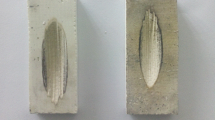Abstract
Silicon carbide (SiC) hybridization's effect on improvising the full potential of polymer composites has been presented. The tribological characteristics (sliding wear and erosive wear) of the SiC filler and SiC-filled glass fiber-reinforced hybrid composites were obtained. The influences of filler content, external load and sliding velocity on the sliding wear behavior of the prepared composites were measured. The solid particle erosive wear test was performed as per ASTM standard, and the influence of im**ement angles as well as filler content on the erosive wear of the composites was studied. From the study, it can be understood that 30% of each constituent, i.e., SiC filler and SiC/woven glass fiber, provide the optimum tribological (both sliding and erosive wear) properties. The microscopic analysis revealed that micro-crack propagation is the prevalent mode of deformation mechanisms observed during the sliding wear test of the samples. Furthermore, during erosion fragmentation of the matrix phase, the formation of micro-craters and grooves is perceived on the worn-out composite surface.









Similar content being viewed by others
References
Hassan A, Salema A A, Ani F N, and Bakar A A, Polym Compos 31 (2010), p. 2079. https://doi.org/10.1002/pc.21006
Jariwala H, and Jain P, J Reinf Plast Compos 38 (2019), p. 441. https://doi.org/10.1177/0731684419828524
Siakeng R, Jawaid M, Ariffin H, Sapuan S M, Asim M, and Sab N, Polym Compos 40 (2019), p. 446. https://doi.org/10.1002/pc.24747
Madhu P, Sanjay M R, Senthamaraikannan P, Pradeep S, Saravanakumar S S, and Yogesha B, J. Nat. Fibers 16 (2019), p. 1132. https://doi.org/10.1080/15440478.2018.1453433
Adekomaya O, Jamiru T, Sadiku R, and Huan Z, J Reinf Plast Compos 35 (2016), p. 3. https://doi.org/10.1177/0731684415611974
Kumar S, and Singh K K, Proc Inst Mech Eng Part L J Mater Des Appl 234 (2020), p. 1439. https://doi.org/10.1177/1464420720941554
Choudhary M, Singh T, Dwivedi M, and Patnaik A, Polym Compos 40 (2019), p. 4113. https://doi.org/10.1002/pc.25272
Suresha B, Siddaramaiah K, Seetharamu S, and Kumaran P S, Wear 267 (2009), p. 1405. https://doi.org/10.1016/j.wear.2009.01.026
Singh T, Puri M, Tejyan S, and Ravi R K, Polym Compos 42 (2021), p. 2817. https://doi.org/10.1002/pc.26016
Karimzadeh A, Yahya M Y, Abdullah M N, and Wong K J, Fibers Polym 21 (2020), p. 1583. https://doi.org/10.1007/s12221-020-9640-2
Abd El–Baky and M A, Kamel M, J Nat Fibers, 18 (2021), p. 213. https://doi.org/10.1080/15440478.2019.1616347
Parikh H H, and Gohil P P, J Reinf Plast Compos 34 (2015), p. 1340. https://doi.org/10.1177/0731684415591199
Chandramohan D, Murali B, Vasantha-Srinivasan P, and Dinesh Kumar S, J Bio- Tribo-Corrosion 5 (2019), p. 1. https://doi.org/10.1007/s40735-019-0259-z
Talib A A A, Jumahat A, Jawaid M, Sapiai N, and Leao A L, Materials (Basel) 14 (2021), p. 1. https://doi.org/10.3390/ma14030701
Vinu K S M, Suresha B, Rajamurugan G, and Megalingam A, Mater Res Express 6 (2019), p. 015307. https://doi.org/10.1088/2053-1591/aae5dc
Nayak S K, and Satapathy A, Proc Inst Mech Eng Part J J Eng Tribol 234 (2020), p. 1846. https://doi.org/10.1177/1350650119896170
Kukshal V, Sharma A, Kiragi V R, Patnaik A and Patnaik T K, In Automotive Tribology, (2019) p. 117. https://doi.org/10.1007/978-981-15-0434-1_7
Kaundal R, Patnaik A, and Satapathy A, Proc Inst Mech Eng Part L J Mater Des Appl 232 (2018), p. 893. https://doi.org/10.1177/1464420716654307
Pradhan S, Acharya S K, and Prakash V, J Appl Polym Sci 138 (2021), p. 50077. https://doi.org/10.1002/app.50077
Pradhan S, and Acharya S K, Proc Inst Mech Eng Part J J Eng Tribol 235 (2021), p. 830. https://doi.org/10.1177/1350650120931645
Vigneshwaran S, Uthayakumar M, and Arumugaprabu V, J Rein Plast and Compos 36 (2017), p. 1019. https://doi.org/10.1177/0731684417699711
Raghavendra G, Ojha S, Acharya S K, and Pal S K, J Compos Mater 48 (2014), p. 2537. https://doi.org/10.1177/0021998313499955
Prakash V, Pradhan S, and Acharya S K, Trans Indian Inst Met 74 (2021), p. 1741. https://doi.org/10.1007/s12666-021-02268-9
Pradhan S, Prakash V, Majhi S, Mohapatra L, Mohanta N and Acharya S K, Trans Indian Inst Met (2022), p. 1. https://doi.org/10.1007/s12666-022-02617-2
Pradhan S, Prakash V, and Acharya S K, Proc Inst Mech Eng Part L J Mat Des App 236 (2022), p. 334. https://doi.org/10.1177/14644207211044716
Nayak S K, Satapathy A, and Mantry S, Poly Comp 41 (2020), p. 3687. https://doi.org/10.1002/pc.25667
Ojha S, Acharya S K, and Gujjala R, Proc Mat Sc 6 (2014), p. 468. https://doi.org/10.1016/j.mspro.2014.07.060
Dalbehera S, and Acharya S K, Adv Polym Tech 37 (2018), p. 240. https://doi.org/10.1002/adv.21662
Acknowledgements
The authors are thankful to the authorities of the Department of Mechanical Engineering, VSSUT Burla, for providing the research facilities.
Author information
Authors and Affiliations
Corresponding author
Additional information
Publisher's Note
Springer Nature remains neutral with regard to jurisdictional claims in published maps and institutional affiliations.
Rights and permissions
Springer Nature or its licensor (e.g. a society or other partner) holds exclusive rights to this article under a publishing agreement with the author(s) or other rightsholder(s); author self-archiving of the accepted manuscript version of this article is solely governed by the terms of such publishing agreement and applicable law.
About this article
Cite this article
Rout, L.N., Mishra, D. & Swain, P.T.R. Influence of Silicon Carbide (SiC) Reinforcement on Sliding and Erosive Wear Characteristics of Glass Fiber/Epoxy Hybrid Composites. Trans Indian Inst Met 76, 1113–1121 (2023). https://doi.org/10.1007/s12666-022-02828-7
Received:
Accepted:
Published:
Issue Date:
DOI: https://doi.org/10.1007/s12666-022-02828-7



